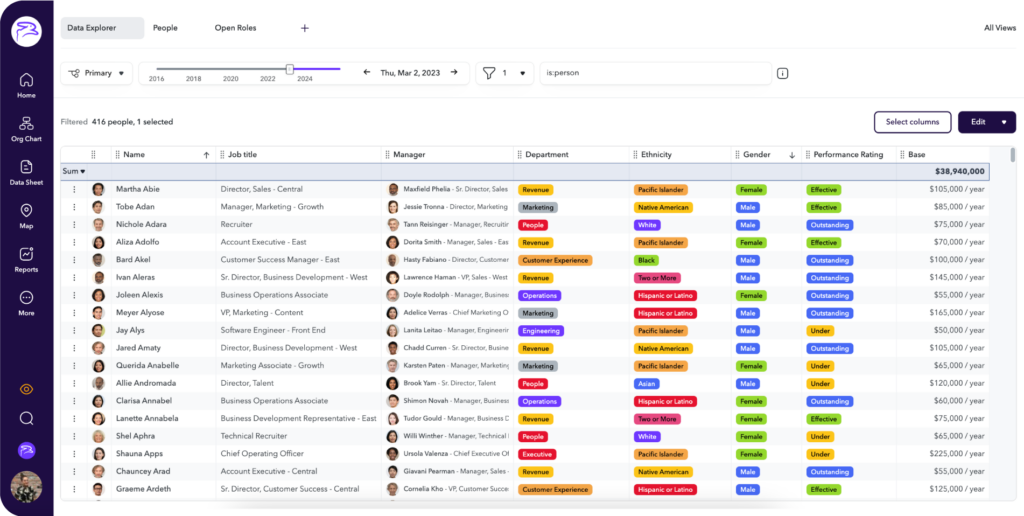
One-third of people don’t believe they’re paid fairly. And with annual studies verifying that pay gaps are still very much real (and really, the difference is quite staggering), it makes sense that employees want to work for an organization where they feel valued and fairly compensated.
Achieving pay equity across an organization is no easy task, but it is possible with an informed, data-driven approach.
Ensuring pay equity is integral for businesses to create a fair and equitable workplace by addressing wage disparities for underrepresented communities.
Achieving pay equity means ensuring that all employees within your organization receive equitable pay for the same work, regardless of their gender, ethnicity, or any other personal attribute. And since pay gaps still exist – especially for members of a historically underrepresented or marginalized groups – it’s necessary to take an intentional approach to ensure you are paying your people fairly and equitably.
By proactively monitoring and reviewing pay gaps across your organization, you can identify and address any potential pay disparities before they become entrenched in your compensation system. And by doing so, you’ll not only foster a more inclusive work environment, you’ll also attract and retain top talent, and see an increase in employee engagement and morale.
A data-based approach to compensation and pay equity will allow you to weed out any unintentional bias in your payroll and create a total rewards strategy that is both fair and competitive. Furthermore, researching where pay gaps exist helps you understand who is experiencing historical pay equity disparities so you make proactive, intentional decisions for your people.
To start building a more equitable workplace, follow the four steps below to create a fair compensation strategy.
When it comes to pay equity, it is important for organizations to take a proactive approach to regularly reviewing and analyzing potential pay gaps. You should therefore conduct a pay gap analysis on a regular basis so that compensation practices within your organization are fair and equitable.
And as part of your pay equity analysis, look for signs of pay inequity that could exist between different self-identifiers, such as gender, race, or age. Additionally, your review should compare salaries across different job functions, departments, and locations.
Then, compare compensation by the variables you can’t control, such as demographics like gender, race, age, sexual orientation, disability, and veteran status. By accessing and drawing insights from people data, you’ll be better equipped to make the right decisions.

Look at your base salaries through a variety of filters, such as gender (pictured above) to understand how compensation differs throughout your company.
Nadia Vatalidis, VP of People of Remote.com, takes pay equity a step further by looking for gaps between her current workforce and new hires. She says, “We knew all our new hires would be reviewed during the offer stage when we hire them, but we also wanted to ensure the whole company gets reviewed and that we proactively analyze and review any pay gaps that might exist.” Her team reviews their data quarterly to guarantee that performance and compensation are reviewed equitably.
The next step in ensuring fair pay is purchasing compensation data, which provides necessary insights to help you identify any discrepancies between your current pay and the market rate for similar positions in their area.
Implementing a paid compensation data tool – such as Radford or PayScale – will give your team access to market compensation data, leveling, and benchmarks for each position within the organization so you can build out compensation ranges (including cash and equity) to better inform your compensation reviews.
By using a data-driven approach to compensation, you can:
Conducting a comprehensive pay equity analysis requires researching more than just general compensation data. To ensure that you are setting fair pay across your organization, it’s important to look at data specific to your industry for a true apples-to-apples comparison.
By taking your industry into account, you can understand how roles within your company compare to those within similar organizations in the same sector. Research what others in your field pay employees by experience level, role, department, location, and company size.
For example, the tech industry has boomed with the rapid adoption of digital services. Therefore, as Alisia Genzler, Group President and Chief Client Officer of Randstad Technologies, states, “It’s no secret that jobs in the technology sector are in high demand and, as a result, command top salaries. Today’s employers want the best and brightest on their teams to ensure innovation, transformation and excellence.”
Alternatively, the Manufacturing and Logistics sector is taking a big hit: it’s predicted that 2.1 million jobs could be left vacant for 2030. Because fewer people are seeking this kind of work, employers are looking to what’s under the umbrella of total compensation, like professional development and benefits, to create a desirable and equitable package for their people.
Thus, with insight into your organization’s size and industry data, you can analyze your compensation and create a tailored pay equity strategy in which everyone receives fair pay and equal opportunities.
When it comes to creating a data-based approach to compensation, it’s important for the Finance and Executive teams to determine where they want to position the organization within the overall market. To do so, you need to select a percentile compared to the rest of your industry that best represents your desired level of compensation.
Percentiles are a representation of a company’s compensation rank within the overall market, and can range from 10th percentile (lowest pay) to 90th percentile (highest pay). You can use this approach to establish base salaries above the median while leaving room for growth and rewarding high performers.
But don’t stop at just considering differences in the market – take it a step further and look at peer-to-peer percentile differences to create a truly equitable compensation plan. Nyala Khan, Former VP of Talent at Eden Health, decided, in collaboration with the Head of Finance, to choose a percentile and held every future Talent Partner accountable to it. She explains: “When we did adjustments and cross-referenced the data by demographics, it was as clean as one could ask for. That said it wasn’t perfect, and we made some “out of equation” edits, so we could stand in front of the company and say no one person in each role/level has a difference of more than 2-3% between their peers, and this difference came after a performance-based merit increase was issued. We continue to curb the idea of negotiating and stick to the given median number in our market data.”

With the right platform, you can keep your percentiles for base pay and raises in one place to guide fair compensation decisions.
Pay equity is an important part of creating a fair and equitable workplace. By taking the time to proactively analyze and review pay gaps, purchase compensation data, and carve out data for your organization and industry, you are creating a better future for your employees.
The above data-based approach to compensation will help ensure that each individual receives fair pay for their contributions to your organization. In fact, a robust pay equity analysis can go a long way in making sure that no employee is left behind when it comes to receiving the compensation they deserve. With the proper pay gap analysis, you can better provide equal opportunities and fair pay for your people from all communities.
Sign up for a free demo today.